In Development this week, Vol. 140, Issue 15
Posted by Seema Grewal, on 16 July 2013
Here are the highlights from the current issue of Development:
From hPSC to mature hepatocyte
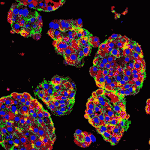 Liver development entails induction of definitive endoderm, specification of the endoderm to a hepatic fate, generation of hepatoblasts, and differentiation of these hepatic progenitors into mature hepatocytes. To date, efforts to generate mature hepatocytes from human pluripotent stem cells (hPSCs) have mainly produced immature hepatocytes. Now, on p. 3285, Gordon Keller and co-workers investigate the mechanisms underlying hepatocyte maturation by manipulating specific signalling pathways at different stages of hepatocyte development in hPSC cultures. The researchers report that sustained activin/nodal signalling is required to pattern the definitive endoderm for hepatic specification. Three-dimensional aggregation of hepatoblasts initiates the maturation of these progenitor cells, and cAMP signalling within the hepatoblast aggregates promotes further maturation to a hepatocyte-like population that expresses metabolic enzymes at levels comparable to those of primary human hepatocytes. These results provide new insights into the pathways regulating hepatocyte maturation from hPSCs, as well as a simple method for generating functional hepatocytes for use in drug metabolism studies and cell-based therapy of liver diseases.
Liver development entails induction of definitive endoderm, specification of the endoderm to a hepatic fate, generation of hepatoblasts, and differentiation of these hepatic progenitors into mature hepatocytes. To date, efforts to generate mature hepatocytes from human pluripotent stem cells (hPSCs) have mainly produced immature hepatocytes. Now, on p. 3285, Gordon Keller and co-workers investigate the mechanisms underlying hepatocyte maturation by manipulating specific signalling pathways at different stages of hepatocyte development in hPSC cultures. The researchers report that sustained activin/nodal signalling is required to pattern the definitive endoderm for hepatic specification. Three-dimensional aggregation of hepatoblasts initiates the maturation of these progenitor cells, and cAMP signalling within the hepatoblast aggregates promotes further maturation to a hepatocyte-like population that expresses metabolic enzymes at levels comparable to those of primary human hepatocytes. These results provide new insights into the pathways regulating hepatocyte maturation from hPSCs, as well as a simple method for generating functional hepatocytes for use in drug metabolism studies and cell-based therapy of liver diseases.
Tbx20 cushions cardiac valve development
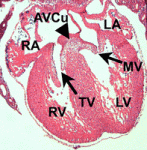 Disrupted development of the cardiac valves – structures that ensure unidirectional blood flow through the heart – causes about a third of human congenital heart defects. The signals that regulate endocardial epithelial-mesenchymal transformation (EMT), an early stage of cardiac valve development, are well understood, but what regulates the later stages of this important developmental process? On p. 3176, Chen-Leng Cai and colleagues report that the T-box transcription factor Tbx20 is expressed in mouse endocardial cushions and valves throughout their development. They show that endocardial Tbx20 expression is not essential for EMT initiation but is required for endocardial cushion maturation and valve elongation in mice. Mechanistically, Tbx20 regulates Lef1 (a transcriptional regulator of Wnt/β-catenin signalling) in cushion endocardial cells, and disruption of Tbx20 expression leads to aberrant Wnt/β-catenin signalling in the endocardial cushions. Thus, the researchers conclude, Tbx20 acts upstream of Wnt signalling to regulate late steps in cardiac valve formation, a finding that provides new insights into the aetiology of human cardiac valve defects.
Disrupted development of the cardiac valves – structures that ensure unidirectional blood flow through the heart – causes about a third of human congenital heart defects. The signals that regulate endocardial epithelial-mesenchymal transformation (EMT), an early stage of cardiac valve development, are well understood, but what regulates the later stages of this important developmental process? On p. 3176, Chen-Leng Cai and colleagues report that the T-box transcription factor Tbx20 is expressed in mouse endocardial cushions and valves throughout their development. They show that endocardial Tbx20 expression is not essential for EMT initiation but is required for endocardial cushion maturation and valve elongation in mice. Mechanistically, Tbx20 regulates Lef1 (a transcriptional regulator of Wnt/β-catenin signalling) in cushion endocardial cells, and disruption of Tbx20 expression leads to aberrant Wnt/β-catenin signalling in the endocardial cushions. Thus, the researchers conclude, Tbx20 acts upstream of Wnt signalling to regulate late steps in cardiac valve formation, a finding that provides new insights into the aetiology of human cardiac valve defects.
Postmitotic retinal cell fates notched up
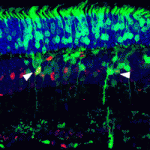 During retinal development, different types of neurons arise in a conserved temporal sequence from multipotent cycling retinal progenitor cells. But do the progenitor cells decide the fate of their daughter cells and pass on this decision via determinants or is the fate of the daughter cells determined postmitotically? Constance Cepko and co-workers (p. 3188) address this question using a conditional allele (N1-CKO) to remove the cell fate regulator Notch1 in newly postmitotic mouse retinal cells. Nearly all newly postmitotic N1-CKO cells become rod photoreceptors, the researchers report, whereas wild-type cells adopt several cell fates: photoreceptors, bipolar cells and Müller glia. Notably, single-cell expression profiling indicates that several direct targets of Notch signalling are differentially expressed in wild-type and N1-CKO cells transitioning from progenitor to differentiated states. These findings suggest that newly postmitotic retinal cells need Notch to escape the photoreceptor fate, and thus may have some degree of plasticity with respect to cell fate.
During retinal development, different types of neurons arise in a conserved temporal sequence from multipotent cycling retinal progenitor cells. But do the progenitor cells decide the fate of their daughter cells and pass on this decision via determinants or is the fate of the daughter cells determined postmitotically? Constance Cepko and co-workers (p. 3188) address this question using a conditional allele (N1-CKO) to remove the cell fate regulator Notch1 in newly postmitotic mouse retinal cells. Nearly all newly postmitotic N1-CKO cells become rod photoreceptors, the researchers report, whereas wild-type cells adopt several cell fates: photoreceptors, bipolar cells and Müller glia. Notably, single-cell expression profiling indicates that several direct targets of Notch signalling are differentially expressed in wild-type and N1-CKO cells transitioning from progenitor to differentiated states. These findings suggest that newly postmitotic retinal cells need Notch to escape the photoreceptor fate, and thus may have some degree of plasticity with respect to cell fate.
Drink, genes and craniofacial defects
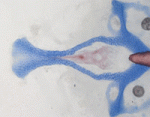 Foetal alcohol spectrum disorders (FASD) encompass a wide range of birth defects that are associated with prenatal exposure to alcohol from mild craniofacial defects to foetal alcohol syndrome. The variability of FASD is partly attributed to the timing and level of foetal alcohol exposure but genetic factors may also influence FASD. To identify potential ethanol-sensitive genes, Johann Eberhart and co-workers have been examining the effects of ethanol on known zebrafish craniofacial mutants. On p. 3254, the researchers report that platelet-derived growth factor receptor alpha (pdgfra) heterozygotes and mutants show enhanced craniofacial defects after ethanol exposure. Other results indicate that Pdgfra has a protective effect that is mediated by the mechanistic target of rapamycin (mTor), part of the phosphoinositide 3 kinase (PI3K) signalling cascade. Finally, analysis of a small database recording human craniofacial features and prenatal ethanol exposure links PDGFRA and PDGFRB variants to particular craniofacial phenotypes. Together, these results suggest that combined genetic and environmental inhibition of PI3K/mTOR signalling leads to variability within FASD.
Foetal alcohol spectrum disorders (FASD) encompass a wide range of birth defects that are associated with prenatal exposure to alcohol from mild craniofacial defects to foetal alcohol syndrome. The variability of FASD is partly attributed to the timing and level of foetal alcohol exposure but genetic factors may also influence FASD. To identify potential ethanol-sensitive genes, Johann Eberhart and co-workers have been examining the effects of ethanol on known zebrafish craniofacial mutants. On p. 3254, the researchers report that platelet-derived growth factor receptor alpha (pdgfra) heterozygotes and mutants show enhanced craniofacial defects after ethanol exposure. Other results indicate that Pdgfra has a protective effect that is mediated by the mechanistic target of rapamycin (mTor), part of the phosphoinositide 3 kinase (PI3K) signalling cascade. Finally, analysis of a small database recording human craniofacial features and prenatal ethanol exposure links PDGFRA and PDGFRB variants to particular craniofacial phenotypes. Together, these results suggest that combined genetic and environmental inhibition of PI3K/mTOR signalling leads to variability within FASD.
Modelling the segmentation clock
 During the patterning of the vertebrate anterior-posterior axis, a gene expression oscillator controls segmentation of the somites, the precursors of the vertebral column. Several mathematical models have been developed to explain how this segmentation clock works. Now, Ahmet Ay, Ertuğrul Özbudak and colleagues (p. 3244) extend these earlier models by developing a multicellular stochastic computational model of the zebrafish segmentation clock. Simulations run with this model show that autoregulatory negative-feedback loops of dimers of Hairy/enhancer-of-split-related (Hes/Her) proteins – transcriptional repressors that are encoded by the only conserved oscillating genes in vertebrates – can drive synchronised gene expression oscillations in wild-type zebrafish embryos and can recapitulate various mutant phenotypes. The model also predicts that synchronised oscillations can only be generated if zebrafish Her proteins have a half-life of less than 6 minutes, a prediction that the researchers validate by showing that zebrafish Her7 has a half-life of 3.5 minutes. Importantly, this model can now be used to make predictions about clock behaviour that can be tested experimentally.
During the patterning of the vertebrate anterior-posterior axis, a gene expression oscillator controls segmentation of the somites, the precursors of the vertebral column. Several mathematical models have been developed to explain how this segmentation clock works. Now, Ahmet Ay, Ertuğrul Özbudak and colleagues (p. 3244) extend these earlier models by developing a multicellular stochastic computational model of the zebrafish segmentation clock. Simulations run with this model show that autoregulatory negative-feedback loops of dimers of Hairy/enhancer-of-split-related (Hes/Her) proteins – transcriptional repressors that are encoded by the only conserved oscillating genes in vertebrates – can drive synchronised gene expression oscillations in wild-type zebrafish embryos and can recapitulate various mutant phenotypes. The model also predicts that synchronised oscillations can only be generated if zebrafish Her proteins have a half-life of less than 6 minutes, a prediction that the researchers validate by showing that zebrafish Her7 has a half-life of 3.5 minutes. Importantly, this model can now be used to make predictions about clock behaviour that can be tested experimentally.
Tightening the netrin on brain repair
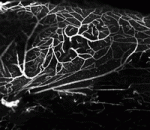 Neural stem cells are maintained in the adult mouse brain within the subventricular zone (SVZ) and help to repair brain damage. In response to demyelination, for example, neural progenitors emigrate from the SVZ and help to repopulate the demyelinated lesion. Here (p. 3107), Myriam Cayre and colleagues investigate progenitor cell emigration from the SVZ in response to lysolecithin-induced focal demyelination in the mouse corpus callosum. The researchers report that demyelination in the corpus callosum triggers vascular remodelling in the SVZ. The remodelled vessels and the neural progenitors exiting from the SVZ are closely associated, they report, and inhibition of post-lesional angiogenesis reduces the migration of progenitor cells towards the lesion. Notably, netrin 1, a factor involved in axonal guidance during brain development, is upregulated within the SVZ after corpus callosum demyelination and is involved in both local angiogenesis and progenitor cell emigration. Together, these results identify netrin 1 as a potential target for the development of therapeutic strategies for brain repair.
Neural stem cells are maintained in the adult mouse brain within the subventricular zone (SVZ) and help to repair brain damage. In response to demyelination, for example, neural progenitors emigrate from the SVZ and help to repopulate the demyelinated lesion. Here (p. 3107), Myriam Cayre and colleagues investigate progenitor cell emigration from the SVZ in response to lysolecithin-induced focal demyelination in the mouse corpus callosum. The researchers report that demyelination in the corpus callosum triggers vascular remodelling in the SVZ. The remodelled vessels and the neural progenitors exiting from the SVZ are closely associated, they report, and inhibition of post-lesional angiogenesis reduces the migration of progenitor cells towards the lesion. Notably, netrin 1, a factor involved in axonal guidance during brain development, is upregulated within the SVZ after corpus callosum demyelination and is involved in both local angiogenesis and progenitor cell emigration. Together, these results identify netrin 1 as a potential target for the development of therapeutic strategies for brain repair.
Plus…
The mechanical control of nervous system development
![]() Based on recent findings, Kristian Franze puts forward the hypothesis that several steps during nervous system development, including neural progenitor cell differentiation, neuronal migration, axon extension and the folding of the brain, rely on or are even driven by mechanical cues and forces. See the Hypothesis article on p. 3069
Based on recent findings, Kristian Franze puts forward the hypothesis that several steps during nervous system development, including neural progenitor cell differentiation, neuronal migration, axon extension and the folding of the brain, rely on or are even driven by mechanical cues and forces. See the Hypothesis article on p. 3069
Cdks, cyclins and CKIs: roles beyond cell cycle regulation
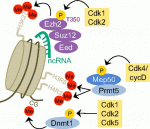 In addition to their function in cell cycle control, it is becoming increasingly apparent that mammalian cyclin-dependent kinases (Cdks), cyclins and Cdk inhibitors (CKIs) play indispensable roles in processes such as transcription, epigenetic regulation, metabolism, stem cell self-renewal, neuronal functions and spermatogenesis. Lim and Kaldis discuss the latest revelations about Cdks, cyclins and CKIs with the aim of showcasing their functional diversity. See the Review article on p. 3079
In addition to their function in cell cycle control, it is becoming increasingly apparent that mammalian cyclin-dependent kinases (Cdks), cyclins and Cdk inhibitors (CKIs) play indispensable roles in processes such as transcription, epigenetic regulation, metabolism, stem cell self-renewal, neuronal functions and spermatogenesis. Lim and Kaldis discuss the latest revelations about Cdks, cyclins and CKIs with the aim of showcasing their functional diversity. See the Review article on p. 3079


 (No Ratings Yet)
(No Ratings Yet)